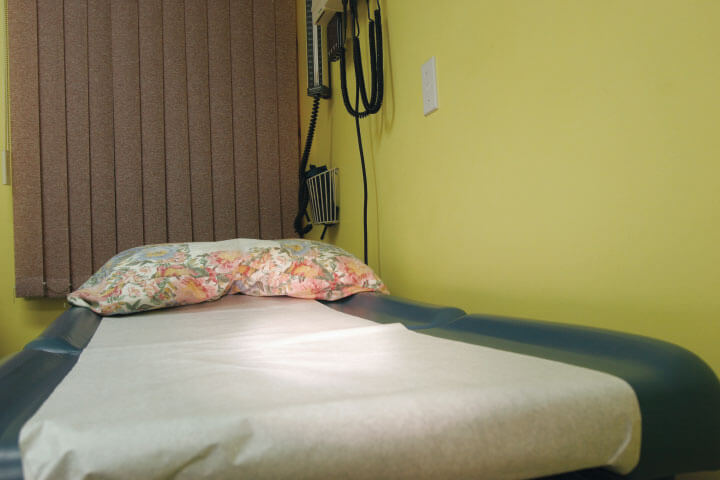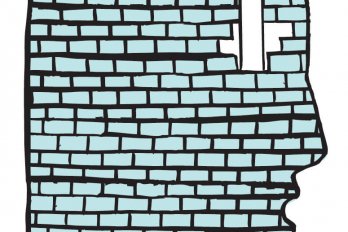Unable to get a university education in her native Romania, Elena Mihu emigrated to Canada, arriving in 1986. She was alone, with a dental technician’s certificate and a hunger for knowledge. In less than ten years, she taught herself English, was accepted into university, and graduated from McMaster University’s medical school. She also owed the government $100,000 in student loans and dearly missed the rural life of her childhood. On weekends she and her husband, Jean-Claude, would drive north in search of country property. On one such trip they found both the perfect home and a “Doctor Wanted” notice pinned to the door of the Kinmount township office.
The sign was not new. For almost six years there had been no local health services in Kinmount, Ontario—no family doctor, no immediate emergency care, with the nearest hospital some twenty kilometres away. The town, cradled by a long bend of the Burnt River at the edge of the Haliburton Highlands, numbered almost 400 permanent inhabitants. Several thousand more people lived in the immediate townships, and each summer the population increased significantly. If you fell ill here, however, you were on your own.
Then suddenly, in 1999, the sign was taken down and a banner welcoming Mihu replaced it. Kinmount, miraculously, had acquired a family physician.
Visit any medical school in Canada and ask, “Who plans to practise family medicine” and too few hands will go up. Having competed with thousands to get into these prestigious schools, and already deeply in debt, most of these ambitious young adults feel they cannot afford to become family doctors in Canada. Without fringe benefits, and after the expenses of renting a clinic, paying for receptionists and nurses, and buying equipment and supplies, a family doctor working forty-hour weeks could expect to take home roughly the salary of a union plumber, auto worker, or skilled bricklayer (around $70,000). But with a few more years of training, medical students can become specialists, virtually guaranteeing them twice the income of a family doctor.
No wonder family medicine is an increasingly unpopular option, especially if it means having to move to a community that cannot provide a job for your spouse or decent schools for your kids. Reside in a Canadian city and you will be lucky to have a family doctor. Move to the suburbs and you can spend years waiting to join a local clinic. Live in rural Canada and there is a good chance that an emergency ward in a distant city will be all your children will ever know. In 2004, almost five million Canadians did not have a family doctor, and in Ontario, according to the Ministry of Health, there are 138 communities facing a critical lack of physicians.
While our attention was focused else-where—on long waiting periods for surgery and spiralling hospital costs—the bedrock of our medical system was eroding. A report by the Society of Rural Physicians of Canada shows that between 1994 and 2000, the number of family doctors practising outside our largest cities declined by 15 percent. Furthermore, a 2004 report by the College of Family Physicians of Canada stated that up to 3,800 physicians were expected to retire over the next two years, among them some 1,400 family doctors. Are we seeing the last of those general practitioners committed to the complete welfare of familiar patients, and, if so, do we truly understand what we are losing
Remember when I was so sick after the flu…remember when I first got chemo…remember when Wayne died?” So starts a conversation between patient and doctor. We ask our physicians not just to cure what ails us but also to bear witness to our lives. The very presence of a doctor in our community means that society cares. The absence can only imply that it does not.
Usually a doctor new to a rural community must buy an existing practice and clinic but Kinmount had neither to sell. Instead the community rented the old township building from the county and, through years of fundraising, saved enough money to renovate and equip the building to a doctor’s specifications. They could now offer this to Mihu as her clinic. They could also offer her a population of roughly 4,000 underserved residents. However, this hunger placed a huge pressure on any doctor coming into the county. Would Mihu burn out before she could make a difference
For decades Kinmount residents had listened to politicians promising better health care. Now that they had found a doctor, many in the community assumed that there would be government support waiting for her. They were wrong. While the official opening of the new clinic made a nice photo op for local and provincial politicians, after that Mihu was essentially left to sink or swim. She had to build the vital networks of emergency care and regional specialists, while her husband returned to his schoolbooks to create a viable business plan for the new clinic. There were no recent models to follow. It had been decades since a doctor had opened a new practice in rural Ontario.
Rural GPs quickly discover that they “are not just physicians, but small-business owners as well. After signing a simple fee-for-service contract with the Ontario Health Insurance Plan (ohip), Mihu was expected to organize an office, hire staff, and pay for insurance, syringes, Q-tips, and all the other tools of her trade before opening for business. Office hours were up to her.
What she could not do was set fees. All Ontario physicians must observe the Schedule of Benefits laid down by the Health Insurance Act. Billing is closely monitored by government auditors and mistakes are quickly censured. But neither medical school nor Jean-Claude’s business degree had trained the couple to easily decipher this 688-page document. For the first few months both worried that they had either billed incorrectly or failed to bill when permissible.
It is easy to see why such a contract encourages doctors to hurry patients through their office. Turn up at a clinic with a nasty cough, sprained neck, or unpleasant rash and you become a Code a005, the bread and butter of the doctor’s income, and are worth $56.10 to your physician. Depending on the complexity of your symptoms and your doctor’s ability to hustle you from the office before you try to squeeze in a few new complaints, the appointment will take about eighteen minutes. That the quick removal of a plantar wart (z103) can be billed at roughly this same amount represents a key flaw in the system. It is easier to itemize a simple medical procedure than a life-saving diagnosis. In the fee-for-service economy, primary care is nearly always short-changed. However thorough or cursory your doctor may be, a general examination can only be billed at $58.20, a house-call at $41.75. A simple birth is worth $395.75; a death certificate costs $17.75.
Kinmount’s new waiting room was filling quickly. While men were initially reluctant to see a woman doctor, by the fourth month Mihu had almost reached her goal of 2,000 patients and had to start a waiting list. Outside office hours she would visit those too ill to attend the clinic. On weekends she plowed through the endless paperwork involved in coordinating the referral of patients sent to distant specialists. Despite the Kinmount Health Committee’s efforts to protect their doctor, Mihu was working a sixty-hour week. For the first few years she did not take holidays or dare to be ill.
Even more stressful was the lack of professional support in the region. Over the last decade the decline of rural fam-ily physicians has been precipitous, but the collapse of rural specialists has been catastrophic. Only 3 percent of Canada’s obstetricians, gynecologists, and psychiatrists, 2 percent of emergency doctors, and 1 percent of pediatricians are located in small towns or rural areas. Other disciplines are often not represented at all.
There is no easy answer to the situation faced by doctors such as Dr. Mihu. The Ontario Ministry of Health, in attempting to help, has urged family doctors to limit each appointment to a single series of symptoms. But many of Mihu’s patients drive in from distant communities, or are forced to bring ailing family members with them, so it is hard to enforce this policy. Yet Dr. Mihu can only bill for providing a single service.
According to the last official census, between 1996 and 2001 Canada’s rural population declined by 286,000 peo-ple. Some losses can be more devastat-ing to small towns than others. When doctors desert a community, a whole chain of events is set in motion. The pharmacy immediately closes and parents with medically frail children make plans to leave. In the city, seniors who were thinking of retiring to bucolic spots think again and buy a condo or retire to Florida. With a shrinking population, the local school has to close, and workers with families request to be posted elsewhere. Soon Main Street is empty and the bank shuts its branch office. All this happened in Kinmount before Mihu arrived. As my neighbour in Kinmount, Tom, used to say, “We’re waiting for them to roll up the road any day now.”
With a newly installed Conservative government elected largely by suburban, small-town, and rural constituents, one would hope that the systemic problems facing rural medicine might now receive more attention. But there is every chance that a Stephen Harper-led government will view Dr. Mihu and Kinmount as an exemplar, not an exception to the growing rule requiring state intervention.
Stubborn and conservative, Kinmount expects very little from Queen’s Park or Ottawa. This makes the residents doubly grateful for the care of their doctor. Her presence in Kinmount has brought a new vitality to the whole community. The town is suddenly full of retirees while parents have stopped worrying about bringing up their children so far from city hospitals. For the first time, a program to beautify the town has been put in place, and pots of flowers line the main street and park. An annual walk-for-health was launched; much of the community turned out to celebrate Mihu’s first year and donated another $10,000 dollars to the clinic. Despite letters from American headhunters offering her positions that would pay substantially more than her present income, Elena and Jean-Claude have no intention of leaving. They are in love with rural Ontario and Canada’s medical system.
Dr. Mihu’s office is full of light. Outside her window the pines of the Ontario Shield have been cut back to let in the sunshine and her patients blink to readjust their eyes after being in the darker waiting room. In many ways Dr. Mihu is the doctor all of us would love to have—caring, dedicated, and knowledgeable. But what is a Dr. Mihu worth to us How do you put a price on the improved quality of life of a whole community
Nostalgia for her rural childhood and gratitude for the opportunities Canada offered her still colour Elena’s life. But few of the students in our medical schools, whether born in Hanoi, Montreal, or small-town Canada, have such altruistic dreams. The provinces may eradicate some of the present barriers against foreign-trained physicians working here, increase enrolment at our medical schools, give bonuses to those willing to practise in rural areas, even develop new medical schools outside the large urban centres. But in the end most medical students will be guided by economic reality, and Elena Mihu, like most family doctors in Canada, will remain grievously underpaid.
While a nation with access to primary care is healthier, happier, and more productive, the social aspect of medicine has been largely forgotten, and a doctor’s familiar bedside manner replaced by the prescription of quick remedies. It is a comfort to know that there are still physicians like Dr. Mihu in Canada, doctors who know us personally and care about our welfare. But perhaps under the current system we just cannot afford this comfort.”



